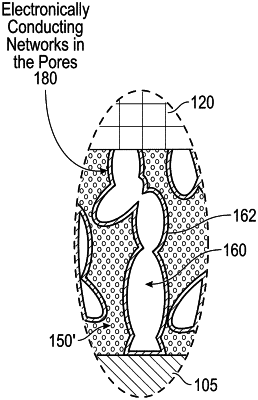| CPC H01M 10/0585 (2013.01) [B29C 64/106 (2017.08); B33Y 80/00 (2014.12); H01M 4/0402 (2013.01); H01M 4/0416 (2013.01); H01M 4/0471 (2013.01); H01M 4/62 (2013.01); H01M 4/624 (2013.01); H01M 4/625 (2013.01); H01M 4/626 (2013.01); H01M 4/64 (2013.01); H01M 4/661 (2013.01); H01M 4/663 (2013.01); H01M 4/664 (2013.01); H01M 4/666 (2013.01); H01M 10/052 (2013.01); H01M 10/0562 (2013.01); H01M 50/183 (2021.01); H01M 50/30 (2021.01); H01M 50/394 (2021.01); H01M 2300/0068 (2013.01)] | 27 Claims |

|
1. A method for forming a 3D porous cathode structure for an electrochemical cell including a cathode, an anode, an electrolyte separator, comprised of a ceramic material, located between the cathode and anode, and a cathode current collector, wherein the cathode comprising the 3D porous cathode structure is located between the cathode current collector and the electrolyte separator, the method comprising:
mixing a first precursor material and a second precursor material together to form a mixture;
depositing the mixture as a layer where the cathode is to be formed; and
sintering the mixture to form the 3D porous cathode structure with ionically conducting electrolyte strands extending through the cathode from the cathode current collector to the electrolyte separator, pores extending through the cathode from the cathode current collector to the electrolyte separator, and an electronically conducting network extending on sidewall surfaces of the pores from the cathode current collector to the electrolyte separator,
wherein the second precursor material is a sacrificial material configured to decompose during formation of the pores by the sintering using the second precursor material, and the first precursor material is a material which forms a coating of the electronically conducting network on the sidewall surfaces of the pores formed by sintering the second precursor material.
|